I start all of my vegetable seeds in homemade compost, as I wrote about last month. (“Can you start vegetable seeds in compost?”) The results are satisfactory. Still I wondered how my seeds would germinate and grow in other composts. Would different composts yield clearly different results?
My experiment compared my compost to two others: the compost that is made at the Miramar Landfill in San Diego; and the compost that is made at Mountain Meadow Mushrooms farm in Escondido and is freely available after it has been used to grow mushrooms.
Let me say right up front that neither of these other composts make any claim about being good to use as a medium in which to sow vegetable seeds. Furthermore, Miramar specifically states, “Planting directly into compost alone is not recommended.” Nevertheless, I was curious to see what would happen if I did.
Results, in short
The vegetable seeds I sowed grew well in my homemade compost, grew acceptably in the mushroom compost, and grew poorly in the Miramar compost. There were clear differences.
Development of experiment
On March 23, 2021 I sowed two sets of seeds in module trays filled with each type of compost. I tried to select vegetable seeds of different types of plants. The seeds were Toma Verde tomatillo, Top Bunch 2.0 collards, Crispino iceberg lettuce, Summer Dance cucumber, Bright Lights chard, Caiman tomato, and Katana tomato.
The composts
At sowing time I noted how each compost smelled, felt, and looked. I also kept in mind how each had been made.
Mine appeared to have the most diverse ingredients. In it I identified bits of leaves, twigs, soil, wood chips, and plenty of aggregates. It smelled neutral, a lot like dirt.
This is in spite of the fact that my compost comes from my mobile chicken pen, into which I continually dump kitchen and garden scraps, wood chips from my tree trimmings, occasionally some horse manure, and I also add some urine. The chickens scratch through everything and add their own manure. They do also incorporate some of the dirt from the ground below. It all breaks down slowly and without ever getting hot.
On the other hand, Miramar compost contains no manure and goes through a hot composting process. Here is what the Miramar website says: “At the Miramar Greenery, compost is made from yard trimmings and food scraps that have been ground, placed in windrows, turned and watered for 70 days. During this time, microorganisms digest the carbon and nitrogen rich mixture, causing the windrow to sustain temperatures of 140-165 F.”
Miramar compost was dark compared to mine, almost black. While I could pick out some small pieces of wood, it also had many fine particles that packed down densely into the module tray’s cells.
The mushroom compost had the most odor. It didn’t smell exactly like manure, but I couldn’t think of a better term to describe its smell even though it was more pleasant than an actual manure odor. The color was a pleasing dark brown. I could see many bits of straw, as well as some aggregates. It was the airiest, the fluffiest of the three composts.
The spent mushroom compost from Mountain Meadows Mushroom farm is made from the straw bedding and manure from the horse stalls at the Del Mar race track, plus gypsum, almond shells, cottonseed hulls, and alfalfa screenings, according to my notes taken during a talk that owner Roberto Ramirez gave recently. The materials are composted for about 20 days.
After the compost is used as a substrate for growing mushrooms, and some nutrients are removed from it during that process, the compost is “spent” and is made available to gardeners and farmers. I loaded my truck with some back in March.
Germination and growth
What do you predict? How will the vegetable seeds come to life within each of these composts?
Here is what I saw:
On April 2, I made this note: “Miramar compost becomes hydrophobic, forming a black crust on the surface. Mine lets in water moderately fast. Mushroom lets in water immediately, fastest.”
At this point, the seedlings in my compost were at transplanting size so I considered the experiment done. Here is what they looked like from another angle on this final day:
Conclusions
From germination through growth up to transplant size, seeds sown in my homemade compost performed best. A higher proportion germinated, and growth was fastest and appeared healthiest.
The mushroom compost performed far better than Miramar but not as well as mine. You could use this mushroom compost for starting vegetable seeds, but it doesn’t appear optimal.
The Miramar compost was not a friendly medium in which to germinate vegetable seeds. Only seven out of twelve cells had any germination — and I’d sown multiple seeds in each cell. The total germination rate was less than 50%.
Here are close-up photos of cucumbers and their roots in each of the composts when I stopped the experiment:
Why the results?
I don’t know for sure why each of these composts achieved different results for this particular task, but I’m going to bring up four points for consideration.
Maybe manure added to compost is helpful, as the two best performers both contained it.
Would the mushroom compost have performed as well as mine — or even better — had it not been partially depleted of nutrients through previously growing a mushroom crop?
Did the dense texture and lack of aggregates (clumps) in the Miramar compost inhibit germination of seedlings as it formed a crust on the surface?
And finally, were there any residues of pesticides and herbicides in the Miramar compost that were detrimental to the growth of these baby vegetables?
In the end, I now feel the need to do a second experiment comparing my compost to commercial composts formulated specifically for starting vegetables.
All of my Yard Posts are listed HERE

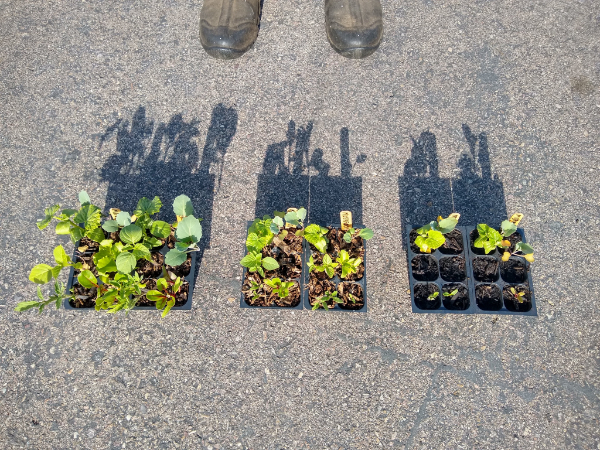
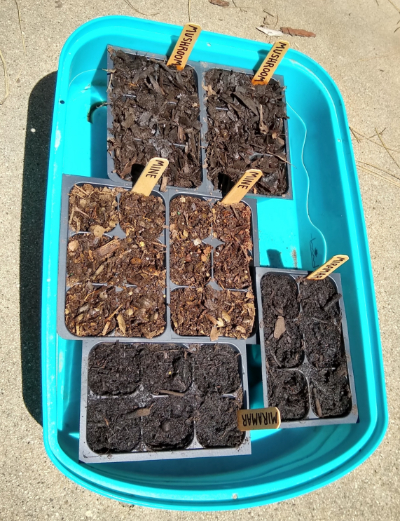
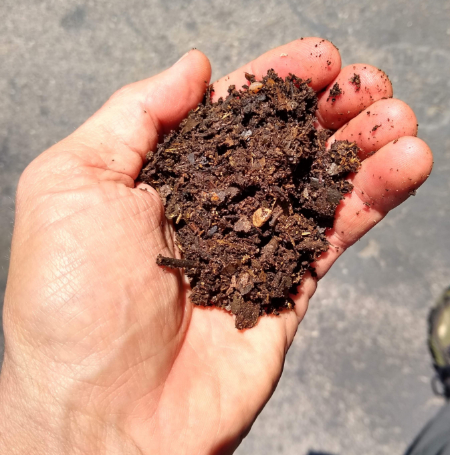

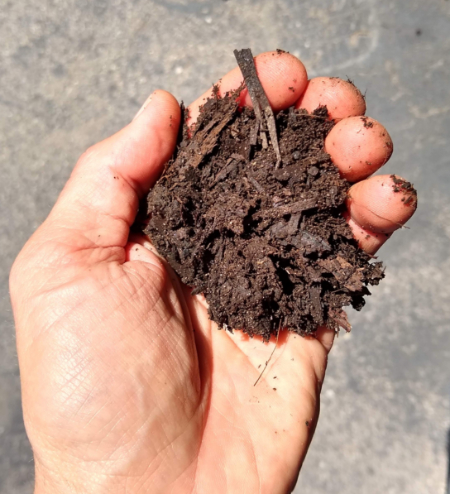


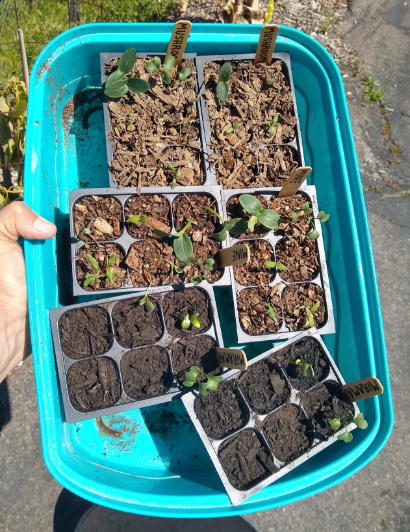

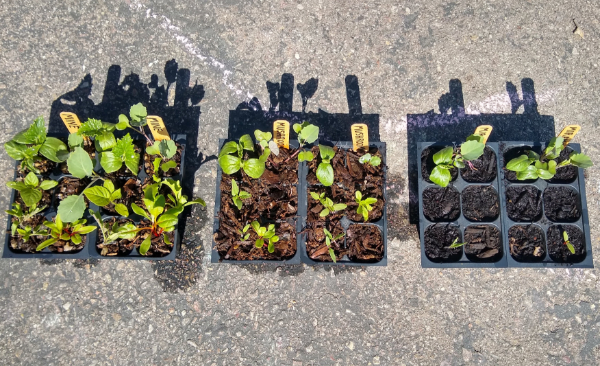

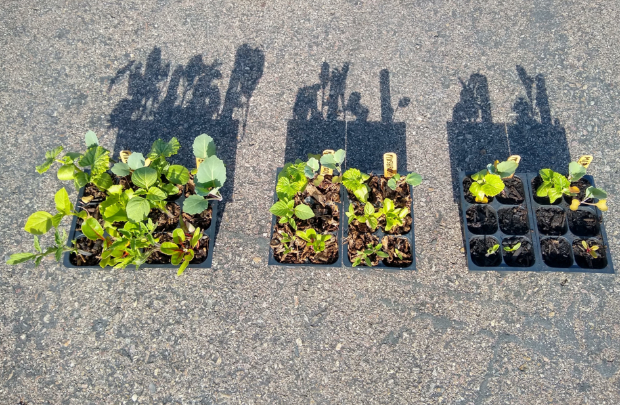


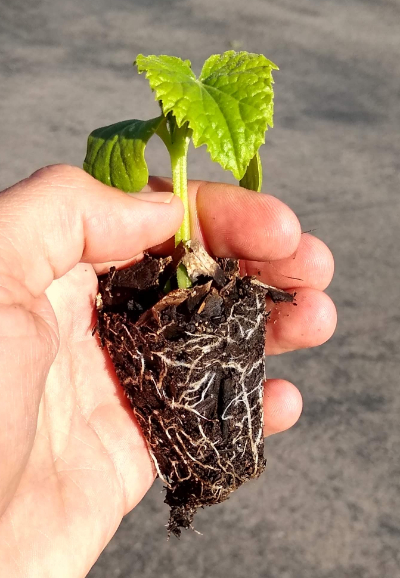



Have you tried the compost at San Pasqual Valley Soils? I’ve had really good luck with their products.
Hi Eric,
I haven’t, but I have neighbors and friends who have and also were very pleased with it. I’ve been meaning to try it myself for years. Thanks for the tip. I’ll plan to get over there and load some soon.
Greg,
It seems to me that the Miramar compost lacks Nitrogen and it shows as yellow edges around the leaves. I start my vegetable seedlings in a compost mix of 60% compost (horse manure, mulch, kitchen scraps and yard grass and plant clippings) , 25% light garden soil and 15% perlite. But i have to always water with a light solution of Nitrogen Sulfite in rain water especially in the colder months when the bacteria in the compost and soil is not very active to add enough nitrogen for the seedlings to grow. The only exception are seeds of zucchini, which love as much compost as you can give them but then again the temperatures are already much warmer in April than in colder months of winter and early spring.
Greg,
Do you vermicompost? I wonder how starting veggies in all or part vermicompost would affect germination rates? I will try this with my fall seed starts. Love this experiment and shared it with my nearby school gardeners.
Hi Heather,
I don’t vermicompost, but I hope you do the experiment and I would love to hear how it goes. Thanks for sharing.
Dear Heather,
I first noticed that any seed in my worm farm sprouted, including apple seeds. Stumps of lettuce and celery sprouted. The worms don’t eat any living plant or seedling. I have had excellent results germinating seeds in worm castings and have even added living worms to the pots. So the answer is a resounding Yes, the environment that worms create supports germination. Is it faster or at a higher survival rate? Haven’t tested that and hope you will share your results!
Thank you for doing this comparison. I live in San Diego and regularly collect free compost and wood mulch from the Miramar greenery. I think it’s a great program and love that they do this! However, I’ve definitely found that if I use TOO much of that compost my raised beds become completely hydrophobic. When I first started my beds I used about 50 percent of the free compost and 25 percent each of vermiculite and perlite. It was a disaster! My plants all struggled (were stunted, pale, and straggly) and dried up, no matter how much I watered, even with a thick layer of mulch on top. Water was just not penetrating more than an inch into the beds. I think the Miramar compost is great for adding minerals to a garden, but because it’s hot-composted, it’s sterile. I needed to add microbes in the form of rotted manure and earthworm compost. Greensand helped too, and any leaf mould I could get my hands on (not easy to come by where there are few deciduous trees!). It’s taken a while but my garden is finally recovering. I still get their compost, but I’m a lot more careful how I apply it now.